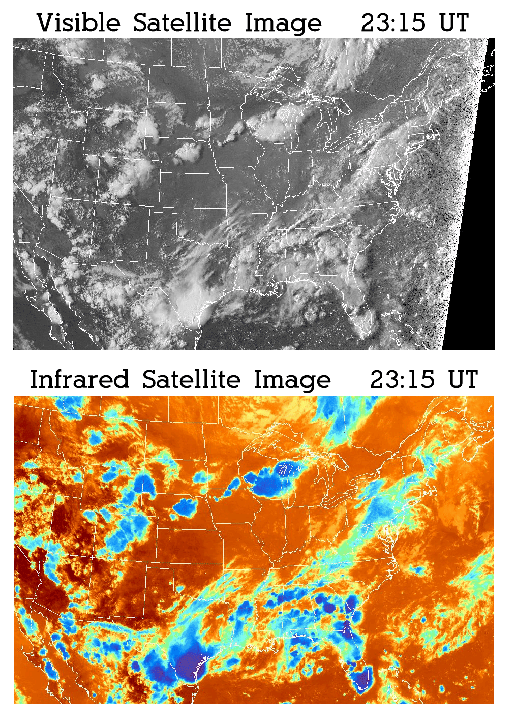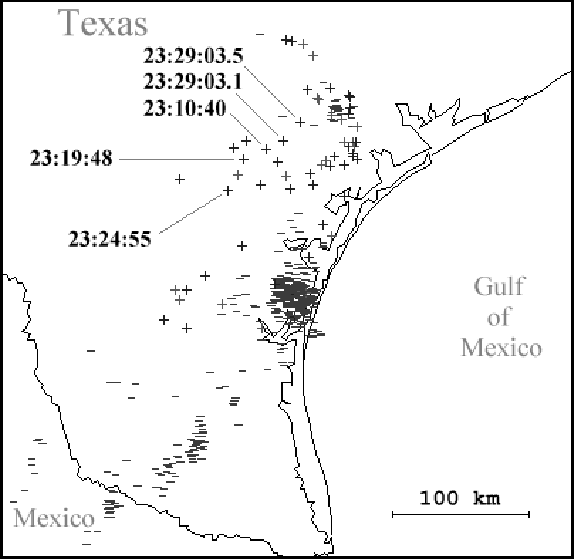



Next: Results
Up: Daytime Sprites
Previous: Instrumentation
Contents
On August 14, 1998, the sferic system was armed between 23:07-23:42 UT
(6:07-6:42 pm CDT). During this time interval, there was a large
mesoscale convective system (MCS) over southern Texas not quite
2 hours remaining before local sunset after 8 pm CDT (see
Figure 4.2). NEXRAD radar data (not shown)
indicated that the areal coverage of base reflectivity ( 15 dBZ) for
this MCS was
15 dBZ) for
this MCS was  66,000 km
66,000 km , which exceeds the mean of
, which exceeds the mean of
 50,000 km
50,000 km for nighttime sprite-producing MCSs
(Lyons et al., 1999). Figure 4.3 shows
National Lightning Detection Network (NLDN) data for southern Texas
during the time period that the sferic system was armed. A horizontal
bipolar pattern is clearly evident, which is a common feature of
nighttime sprite-producing MCSs (Lyons, 1996; Boccippio et al., 1995).
for nighttime sprite-producing MCSs
(Lyons et al., 1999). Figure 4.3 shows
National Lightning Detection Network (NLDN) data for southern Texas
during the time period that the sferic system was armed. A horizontal
bipolar pattern is clearly evident, which is a common feature of
nighttime sprite-producing MCSs (Lyons, 1996; Boccippio et al., 1995).
Figure 4.2:
The GOES-8 visible satellite image of the
United States (top) at 23:15 UT, August 14, 1998,
 5 min prior to the first sprite event. The
diagonal line over the Atlantic Ocean on the right side
of the image is the terminator, or ``sunset'' line. The
GOES-8 infrared satellite data is shown at the bottom for
the same time and region. The darkest blue colors
correspond to cloud tops of about
5 min prior to the first sprite event. The
diagonal line over the Atlantic Ocean on the right side
of the image is the terminator, or ``sunset'' line. The
GOES-8 infrared satellite data is shown at the bottom for
the same time and region. The darkest blue colors
correspond to cloud tops of about  65
65 C. A
large MCS over southern Texas is evident in both
pictures, with the infrared indicating an average cloud
top temperature below
C. A
large MCS over southern Texas is evident in both
pictures, with the infrared indicating an average cloud
top temperature below  60
60 C over a large
area. The images were obtained from http://www.rap.ucar.edu/weather/satellite.html.
C over a large
area. The images were obtained from http://www.rap.ucar.edu/weather/satellite.html.
 |
Figure 4.3:
National Lightning
Detection Network (NLDN) data for a Mesoscale Convective
System (MCS) over southern Texas is displayed for the
time period 23:07-:42 UT on August 14, 1998. The five
energetic +CGs discussed in this section are labeled.
 |




Next: Results
Up: Daytime Sprites
Previous: Instrumentation
Contents
Mark Stanley
2000-10-22
![]() 15 dBZ) for
this MCS was
15 dBZ) for
this MCS was ![]() 66,000 km
66,000 km![]() , which exceeds the mean of
, which exceeds the mean of
![]() 50,000 km
50,000 km![]() for nighttime sprite-producing MCSs
(Lyons et al., 1999). Figure 4.3 shows
National Lightning Detection Network (NLDN) data for southern Texas
during the time period that the sferic system was armed. A horizontal
bipolar pattern is clearly evident, which is a common feature of
nighttime sprite-producing MCSs (Lyons, 1996; Boccippio et al., 1995).
for nighttime sprite-producing MCSs
(Lyons et al., 1999). Figure 4.3 shows
National Lightning Detection Network (NLDN) data for southern Texas
during the time period that the sferic system was armed. A horizontal
bipolar pattern is clearly evident, which is a common feature of
nighttime sprite-producing MCSs (Lyons, 1996; Boccippio et al., 1995).

